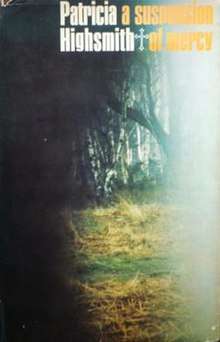A Suspension of Mercy
 First UK edition | |
| Author | Patricia Highsmith |
|---|---|
| Language | English |
| Genre | Thriller |
| Set in | Suffolk, England |
| Published | Heinemann (1965) |
| Pages | 251 |
A Suspension of Mercy (1965) is a psychological thriller novel by Patricia Highsmith. It was published in the US under the title The Story-Teller later the same year by Doubleday.[1] It was the eleventh of her 22 novels.
Composition
The protagonist's surname refers to Herman Melville's short story "Bartleby, the Scrivener" and its enigmatic title character.
Synopsis
Sydney Bartleby is an American novelist living near Framlingham, Suffolk with his English wife Alicia. Although seemingly idyllic, their married life is secretly marked by tension, frequent separations and sometimes domestic abuse. Sydney and his writing partner Alex work together on a crime serial that they attempt to sell to British television. Alicia decides suddenly that their marriage merits a trail separation, and Sydney agrees. The morning after she leaves, Sydney, for inspiration, pretends to have murdered her, carries an empty carpet to his car and drives to bury it in the countryside before returning home. Shortly afterwards, however, many of Alicia's acquaintances claim to have lost contact with her, and she is declared missing. The spectre of doubt falls on Sydney, after one of his neighbours, Mrs. Lilybanks, tells the police that she saw him drive away a carpet the morning after Alicia was last seen.
Alicia is alive, however, and living with her extra-marital lover Edward Tilbury in Brighton under an assumed name. Edward becomes uncomfortable with the media circus around her disappearance, though Alicia insists that they continue living their ruse. She claims that Sydney is becoming increasingly mentally unstable. Sydney, meanwhile, is becoming more heavily implicated after flippant jokes he makes to Alex are taken seriously, and a notebook in which he hypothetically details Alicia's murder is found by police. Although police manage to dig up the empty carpet buried by Sydney, things become worse when Sydney, going to tell Mrs. Lilybanks of the news, inadvertently gives her a heart attack when she sees him and thinks he is about to attack her. Although clouded by suspicion, police cannot definitively prove that he intentionally caused the deaths of either Alicia or Mrs. Lilybanks.
Sydney eventually travels to Brighton, where he suspects Alicia to be staying, and manages to find her and Edward. He does not confront her, however, or alert the police. Instead, after the sale of his and Alex's serial is postponed due to Sydney's notoriety, he sends her a letter imploring her to give herself up. Alicia becomes distraught, and, after a hysterical fight with Edward, runs from their house. The next morning, police find Alicia's body at the bottom of a cliff. Her death is ruled a suicide and Sydney is cleared of suspicion. Sydney, however, tracks down Edward Tilbury at his London flat and murders him by forcing him to overdose on sleeping pills. The plan succeeds, though not entirely successfully as Sydney is identified by one of Edward's neighbours of having been seen entering Edward's flat shortly before his death. Sydney admits he had spoken briefly to him about Alicia before leaving, and, due to lack of evidence, is once again acquitted while still under heavy suspicion.
Reception
In The New York Times, Anthony Boucher wrote: "It's a curious and absorbing novel, almost unique in its fantastic and ironic tone".[2]
Highsmith's biographer Andrew Wilson calls this work "the author's most postmodern novel" and describes it as "a literary hall of mirrors in which reality and fiction are constantly reflected and, ultimately, confused".[3]
References
- ↑ "Patricia Highsmith Bibliography". Classic Crime Fiction. Retrieved 13 December 2014.
- ↑ Veale, Scott (September 2, 2001). "New & Noteworthy Paperbacks". The New York Times. Retrieved December 9, 2015.
- ↑ Andrew Wilson, Beautiful Shadow,